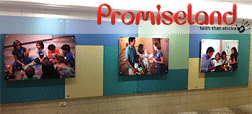
By Phil Miglioratti
One of the originators of Willow Creek Church’s Promiseland shares the intentions and values of that early program.
Standing in the middle of a movie theater lobby is usually no big deal (and certainly not a spiritual moment), unless it is the first Sunday morning of Promiseland, a new ministry to children in the early days of Willow Creek Community Church. Launching a ministry to kids in an out-of-the-box, rapidly-growing, already-influential congregation was a big deal; even bigger than I realized at the time, Willow Creek church in South Barrington, IL, about to surpass the 2,000 milestone in its third year, presented a brand new approach to “church” with fresh thinking from top to bottom – except when it came to children.
Birthed out of the innovative Son City youth ministry that reached 1,300 students weekly, the Willow Creek experience applied those ground-breaking principles and practices to non-churched adults.
Thirty-seven plus years later those new ideas may be standard operating procedures in thousands of churches across the globe, but it took some time for them to travel from the theater seats to the lobby floor where scores of infants through sixth graders congregated.
As senior pastor Bill Hybels said in 2005 with Christianity Today: “I admit I was a late-arriver to see the value children’s ministry could bring to Willow Creek. It started when, occasionally, a mother or father would share excitement over how much their kids learned in Promiseland. Parents noticed that their kids were changing, and that grabbed my attention.”
“I never really looked at children’s ministry as a place where scores or even hundreds of volunteers could find their most meaningful place of service in the church,” Hybels commented. “I always thought most people would find that adult ministry was the place to use their gifts. But a picture was developing of kids’ lives changing—and a place where significant numbers of volunteers were using their spiritual gifts.”
Though I had followed the Son City phenomenon from afar (serving 60 miles northwest in Rockford, IL), I had been immersed in the Awana Youth Association culture from which Dave Holmbo and Bill Hybels created the architecture of first Son City, then applied those insights and ideas to Willow Creek. Awana’s red-blue-yellow-green lined square where teams faced-off became the red and blue and even “clear” teams for Son City competition, which became the adult fellowship “modules” in the early days of this new styled church.
lined square where teams faced-off became the red and blue and even “clear” teams for Son City competition, which became the adult fellowship “modules” in the early days of this new styled church.
So, when it came to designing the next stage of Willow Creek’s children’s ministry, I was in good company: biblically-grounded, creative-thinking, risk-taking unbound-by-tradition leaders. Here is what we brought to the drawing board:
- Every person (every child) is valuable to God
- Learning is best retained when the learner is involved in the process
- Scriptural truths transform lives
- Love and joy create community
- Young-in-the-faith believers are enthusiastic leaders
So we took the following steps in those early days of Promiseland:
- We based every Sunday session on a promise of God from the Bible so that even the youngest child began their theological journey knowing God loves them and has good purposes for their lives now and in eternity.
- As parents of young children, we knew faith-learning was stifled if kids were forced to be silent and be still (basically to make it easier for the adult teachers) so we created a “Together Time” that was participatory — now tame compared to the technological advances in music and visual media, “The Kids’ Quiz Show,” memorizing scripture by pinning the words in correct order on a clothesline and singing along to Barry McGuire’s Bullfrogs & Butterflies was truly exciting and engaging then.
- Enthusiastic volunteers were called learning leaders as a way of placing traditional teaching methods into a grander concept of life-transforming, life-long learning . While many were short on theological training or biblical knowledge and some had not grown up in Sunday school, they eagerly accepted the responsibility to take the lead in gathering, leading, teaching and discipling the learners in their age-level group.
- Rather than replying on published resources, I wrote a simple curriculum that provided the promise, the scripture text, a related biblical story, and several activity suggestions, but each learning leader was responsible to build a 45 minute (not including Together Time) session. Surprisingly, discipline problems were minimal, possibly because we were committed to designing an experience that included audio (learn by listening/talking) + video (learn by watching/looking/ drawing) + cardio (learn while moving/acting/responding). Learners participated in the learning event.
- We also knew that effective learning had to be affirmed and modeled at home. I wrote a simple Family Guide with each Sunday’s promise, scripture, story and several fun age-level appropriate activities for families. Family night was a combination of popcorn and praise!
How times have changed
Now, three and one half decades later, children enjoy Promiseland in a spacious new facility outfitted with high tech media, live music, tables and sinks and more.
The task is to keep the main thing the main thing: growing mature faith, hope and love into every kid God brings our way — while looking for ways to improve communication and increase accessibility to the life-changing content of holy Scripture. Practices change. Trends challenge traditions. New becomes old. Culture morphs and evolves.
And as it does, young, new, fresh-thinking leadership must meet the challenge to change the way we tell the old, old story of Jesus and his love. New wine needs new wineskins.
Phil Miglioratti is COO of Mission America Coalition www.missionamerica.org, and founder of National Pastors’ Prayer Network www.nppn.org.


